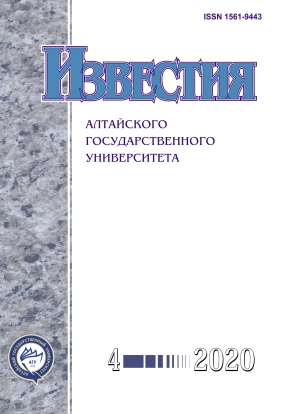Experimental Investigation of Diopside Melt Viscosity at High Pressure
УДК 53:549.642.21
Abstract
This paper presents the experimental evaluation of viscosity of the diopside-based model composition conducted at high P-T parameters (at the pressure of 4 GPa and in the temperature range of 1750°C - 1800°C) in the presence of olivine crystals. The experiments are carried out using the multi-anvil high-pressure apparatus of the “split-sphere” type (Russian acronym — BARS) according to the falling sphere method. The traveling time of a platinum (Pt) sphere in a melt is one of the parameters measured in experiments. Measurement of this parameter starts when the given P-T values are attained and stops when the electric current is turned off. There are three main positions of the Pt sphere observed in the experiments. Viscosity is calculated using the Stokes’ Law. It is found out that the Pt sphere velocity decreases expectedly as the relative viscosity of such heterogeneous compositions (liquid + solid phase) increases (in contrast to homogeneous melts). Viscosity values remain low when there is up to 7-10 wt-% of solid phase crystals in magma. The increase of olivine xenocrysts in magma leads to the progressive increase of viscosity values of the melt: by 1.5-2 orders of magnitude at 20-25 wt-%, by 3-3.5 orders of magnitude at 35-40 wt-%. The obtained experimental results allow concluding that the amount of solid phase in magma should be sufficiently low (less than 20-30 wt-%), otherwise, melts of the investigated composition can be moved only by explosive processes.
Downloads
Metrics
References
Pinkerton H., Stevenson R.J. Methods of determining the rheological properties of magmas at sub-liquidus temperatures // J. of Volcanology and Geothermal Res. 1992. V. 53. DOI: 10.1016/0377-0273(92)90073-M.
Saar M.O., Manda M. Continuum percolation for random by oriented soft-core prisms // Physical Review E. 2002. V. 65. DOI: 10.1103/PhysRevE.65.056131.
Caricchi L., Burlini L., Ulmer P et.al. Non-Newtonian reology of crystal-bearing magmas and implications for magma ascent dynamics // Earth and Planet. Sci. Lett. 2007. V. 264. DOI: 10.1016/j.epsl.2007.09.032.
Castruccio A., Rust A.C., Sparks R.S.J. Rheology and flow of crystal-bearing lavas: Insights from analogue gravity currents // Earth and Planet. Sci. Lett. 2010. V. 297. DOI: 10.1016/j.epsl.2010.06.051.
Hobiger M., Sonder I., Buttner R., Zimanowski B. Viscosity characteristics of selected volcanic rock melts // J. of Volcanology and Geothermal Res. 2011 V. 200. DOI: 10.1016/j.jvolgeores.2010.11.020.
Bouhifd M.A., Richer P, Besson P et.al. Redox state, microstructure and viscosity of partially crystallized basalt melt // Earth and Planet. Sci. Lett. 2004. V. 218. DOI: 10.1016/S0012-821X(03)00641-1.
Чепуров А.И., Жимулев Е.И., Сонин В.М. и др. Экспериментальная оценка скорости гравитационного фракционирования ксенокристаллов в кимберлитовой магме при высоких Р-Т параметрах // Доклады АН. 2011. Т. 440. № 5.
Чепуров А.И., Федоров И.И., Сонин В.М. Экспериментальное моделирование процессов алмазообразования. Новосибирск, 1997.
Чепуров А.И., Федоров И.И., Сонин В.М. Экспериментальные исследования образования алмаза при высоких Р-Т параметрах // Геология и геофизика. 1998. Т. 39. № 2.
Liebske C., Schmickler B., Terasaki H. et al. Viscosity of peridotite liquid up to 13 GPa: Implications for magma ocean viscosities // Earth and Planet. Sci. Lett. 2005. V. 240. DOI: 10.1016/j.epsl.2005.10.004.
Sakamaki T., Ohtani E., Urakawa S. et al. Measurement of hydrous peridotite magma density at high pressure using the X-ray absorption method // Earth and Planet. Sci. Lett. 2009. V. 287. DOI: 10.1016/j.epsl.2009.07.030.
Ardia P., Giordano D., Schmidt M.W. A model for the viscosity of rhyolite as a function of H2O-content and pressure: A calibration based on centrifuge piston cylinder experiments // Geochim. et Cosmochim. Acta. 2008. V. 72. DOI: 10.1016/j.gca.2008.08.025.
Reid J.E., Suzuki A., Funakoshi K. et al. The viscosity of CaMgSi2O6 liquid at pressures up to 13 GPa // Physics of the Earth and Planet. Interior. 2003. V. 139. DOI: 10.1016/ S0031-9201(03)00143-2.
Sato H. Viscosity measurement of subliquidus magmas: 1707 basalt of Fuji volcano // J. of Mineral. and Petrol. Sci. 2005. V. 100. DOI: 10.2465/jmps.100.133
Moss S., Russell J.K., Brett R.C., Andrews G.D.M. Spatial and temporal evolution of kimberlite magma at A154N, Diavik, Northwest Territories, Canada // Lithos. 2009. V. 112. DOI: 10.1016/j.lithos.2009.03.025.
Izvestiya of Altai State University is a golden publisher, as we allow self-archiving, but most importantly we are fully transparent about your rights.
Authors may present and discuss their findings ahead of publication: at biological or scientific conferences, on preprint servers, in public databases, and in blogs, wikis, tweets, and other informal communication channels.
Izvestiya of Altai State University allows authors to deposit manuscripts (currently under review or those for intended submission to Izvestiya of Altai State University) in non-commercial, pre-print servers such as ArXiv.
Authors who publish with this journal agree to the following terms:
- Authors retain copyright and grant the journal right of first publication with the work simultaneously licensed under a Creative Commons Attribution License (CC BY 4.0) that allows others to share the work with an acknowledgement of the work's authorship and initial publication in this journal.
- Authors are able to enter into separate, additional contractual arrangements for the non-exclusive distribution of the journal's published version of the work (e.g., post it to an institutional repository or publish it in a book), with an acknowledgement of its initial publication in this journal.
- Authors are permitted and encouraged to post their work online (e.g., in institutional repositories or on their website) prior to and during the submission process, as it can lead to productive exchanges, as well as earlier and greater citation of published work (See The Effect of Open Access).








